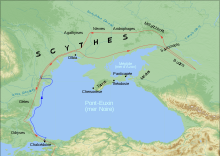| Scythian campaign of Darius I | |||||||
|---|---|---|---|---|---|---|---|
 Map of the European Scythian campaign of Darius I | |||||||
| |||||||
| Belligerents | |||||||
|
Ionian allies | Royal Scythians | ||||||
| Commanders and leaders | |||||||
|
Ionian allies: Miltiades the Athenian Strattis of Chios Histiaeus of Miletus Coes of Mytilene |
Idanthyrsus Scopasis Unnamed others | ||||||
| Units involved | |||||||
| Mostly infantry;[1] 80,000 after Darius' return to Asia (Herodotus)[2] | Unknown number of Scythian horsemen[3] | ||||||
The Scythian campaign of Darius I was a military expedition into parts of European Scythia by Darius I, the king of the Achaemenid Empire, in 513 BC.[4] The Scythians were an East Iranian-speaking people who had invaded Media, revolted against Darius and threatened to disrupt trade between Central Asia and the shores of the Black Sea as they lived between the Danube and Don Rivers and the Black Sea.[5][6] The campaigns took place in parts of what is now the Balkans, Ukraine, and southern Russia.
The Scythians managed to avoid a direct confrontation with the Persian army due to their mobile lifestyle and lack of any settlement (except Gelonus), while the Persians suffered losses due to the Scythians' scorched earth tactic. However, the Persians conquered much of their cultivated lands and damaged their allies, forcing the Scythians to respect the Persian force. Darius halted the advance to consolidate his gains, and built a defence line.
Practically everything that is known of this campaign is from Herodotus's book The Histories; almost no Persian sources exist, and no Scythian ones. As a result, it is difficult to know for sure how much of Herodotus's account is accurate.
- ^ Herodotus, Histories, 4.136.2
- ^ Herodotus, Histories, 4.143.3
- ^ Herodotus, Histories, 4.136.2
- ^ Miroslav Ivanov Vasilev. "The Policy of Darius and Xerxes towards Thrace and Macedonia" ISBN 9004282157 p 70
- ^ Shahbazi 1996, p. 41.
- ^ Woolf 2004, p. 686.